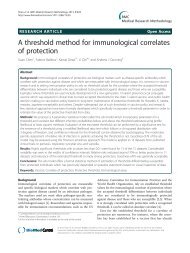PDF - BioMed Central
PDF - BioMed Central
PDF - BioMed Central
Create successful ePaper yourself
Turn your PDF publications into a flip-book with our unique Google optimized e-Paper software.
Xenoulis et al. BMC Veterinary Research 2013, 9:47 Page 6 of 11<br />
http://www.biomedcentral.com/1746-6148/9/47<br />
Figure 3 Representative continuous lipoprotein density profile from a dog of group 1 (normolipemic dogs of breeds other than<br />
Miniature Schnauzers). Intensity refers to the number of pixels of fluorescence emission recorded. The x-axis provides the distance in mm from<br />
the top of the 33 mm ultracentrifuge tube. This dog had serum TAG and cholesterol concentrations within the respective reference intervals. The<br />
most abundant lipoprotein fractions are R7 and R8 (which correspond to a density for HDL), seen at a tube coordinate between 23 mm and 31 mm.<br />
R2 to R6 fractions (corresponding to LDL densities) are present in very small amounts and are seen at a tube coordinate between 9 mm and 23 mm. The<br />
R1 fraction (that corresponds to TRL densities) appears at tube coordinates of 6 mm to 9 mm in very small amounts.<br />
other breed) could be accurately predicted based on<br />
their lipoprotein profiles in 85% of the cases (Eigenvalues=0.5455;<br />
p=0.00017; Figure 5). Specifically, 90% of<br />
Miniature Schnauzers could be classified as Miniature<br />
Schnauzers, and 80% of dogs of other breeds could be<br />
classified as other breeds based on their lipoprotein profiles<br />
alone. The most important lipoprotein fractions<br />
that served as predictors were the R1, and R5 - R6<br />
(d = 1.038-1.063 g/mL) (Figures 3 and 4). Normolipemic<br />
Miniature Schnauzers had more prominent R1 (likely TRL)<br />
Figure 4 Representative continuous lipoprotein density profile from a dog of group 2A (normolipemic Miniature Schnauzers). Axes<br />
descriptions are provided in Figure 4 legend. This Miniature Schnauzer had serum TAG and cholesterol concentrations within the respective<br />
reference intervals. The CLPDP of these dogs were generally similar to those of group 1 (Figure 4) with regard to the abundance of major<br />
lipoprotein classes. However, most dogs in group 2A showed more abundant R1 and less abundant R2 – R6 fractions compared to group 1 dogs.
















